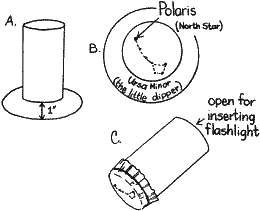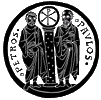For I will behold the heavens, the works of Thy fingers, the moon and the stars, which Thou hast founded. (Psalm 8).
Many centuries ago men were beginning to realize that the physical world was governed by unchanging laws. Thus scientists of every type have been studying, experimenting with, and observing these laws for a long time. Each generation has built on the knowledge written down for them by earlier scientists.
How to Be a Scientist
1. Think your project through.
2. Read widely.
3. Question others. Talk with teachers, parents, other adults, and school friends
interested in the same field.
4. Work carefully as you go.
5. Do not be foolhardy. Dangerous materials should not be used by a young scientist
except under the supervision of an informed adult.
6. Observe carefully. Learn to see the world about you.
Astronomy
Astronomy is the study of the heavens: the constellations, which are groups of stars that have seemed to form a picture; the planets, which are satellites circling our most important star, the sun; and the stars themselves, the glowing heavenly bodies from which the planets receive reflected light.
The planets and stars are not so difficult to learn if the memory tricks given in many books are mastered first. The end stars of the most famous constellation, the Big Dipper, for example, point to the North Star — which is the last star in the handle of the Big Dipper. The Big Dipper's curving handle points directly to Arcturus — and that is a big reddish-orange beauty, the major star in the constellation Boötes (The Herdsman). These are just a few of many memory tricks.
The location of the constellations at the four seasons may be found in a number of books, kits, or charts. Such reference materials also show individual constellations with drawings picturing how they appeared to the Greeks who named them so long ago.
A moonless night is best for observation. With book or chart and a flashlight, locate the constellations. Then make "stargazers" so that you will know your favorite constellations without referring to a book.
Astronomy Activities
To understand day and night, imagine a flashlight is the sun and a ball the earth. Darken the room and flash the light on the ball. Turn the ball slowly from west (left) to east (right). This demonstrates how there can be dawn, daylight, twilight, and night in different parts of the world at the same time.
Telescope: At an optometry store, buy two lens holders and two inexpensive lenses, one thin convex lens and one thick convex lens. Place the lenses in the lens holders. Using a long stick (for example, a yard stick turned on edge, or a dowel) firmly wire the thin lens about one inch from one end of the stick. Wire the thick lens one inch from the other end, but loosely enough to slide backward and forward slightly.

Look at objects through this telescope. They will seem larger and closer. Be sure to look from the thick-lens end, adjusting this lens as necessary.
Stargazer: Save cardboard tubes from paper towels, bathroom tissue, or foil. Stand the tube on black paper and with a pencil trace the end of the tube. Draw another circle that is one inch larger all around (A). Cut out the circle on the outside line.

Within the inner circle, draw a constellation, following a pattern from a book. Make a hole for each star using a straight pin. Punch smaller holes for the dimmer stars (B). Tie or tape the black circle to the end of the tube, or hold it with a rubber band.(C). Print the name of the constellation on the side of the tube. Do this for several constellations.
The easiest way to observe through a "stargazer" is to go into a darkened room. Insert a flashlight into the tube (about 1 inch in) and aim the tube at the ceiling Spots of light, shining through the pinpricks, will make up an enlarged constellation.
If you use an oatmeal or salt box, you can take off the lid and punch out a diagram of a constellation in the other end. Draw the reversed image of a constellation on the outside of the bottom end before you punch the holes.
